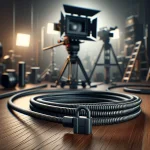Cable ties, those small but mighty tools, are indispensable in the world of film production. Often overlooked, they play a crucial role in ensuring safety and efficiency on set. From organizing cables to securing props, zip ties help keep the chaos of production under control, making them a true behind-the-scenes hero.
In this blog post, we'll explore the various uses of cable ties in film production, highlighting their importance and versatility. Whether you're a seasoned filmmaker or just starting out, understanding how to effectively use cable ties can greatly enhance your production process.
The Critical Role of a Cable Tie on Set
Zip ties serve multiple purposes on a film set, primarily focusing on cable management and safety. Every set is filled with a myriad of cables that power lights, cameras, and other essential equipment. Properly securing these cables is crucial to prevent accidents such as tripping, which can lead to injuries or damage to expensive gear. Zip ties ensure that all cables are neatly organized and securely fastened, reducing the risk of such incidents.
Moreover, zip ties are not just for cables. They are also used to fasten backdrops, secure light fixtures, and even assist in quick costume repairs. Their versatility makes them a must-have in any production toolkit. The ease of use and the ability to quickly release and adjust them makes zip ties perfect for the dynamic environment of film production.
Varieties and Selection for Optimal Use
Choosing the right type of cable tie is essential for meeting the specific needs of a film production. There are several varieties of zip ties available, each suited for different tasks. Standard nylon zip ties are the most common and are great for general use, but there are also specialized ties like Velcro or reusable ties which are perfect for temporary setups where adjustments might be needed frequently.

For outdoor shoots or harsh environments, UV-resistant and weatherproof zip ties are available to withstand extreme conditions. Selecting the appropriate type of cable tie based on the environment and the specific needs of the production ensures reliability and effectiveness.
Best Cable Ties Practices for Cable Management
Effective cable management is more than just using zip ties. It involves planning and execution to ensure that all cables are routed safely and efficiently. Start by assessing the set and identifying all potential hazards. Use zip ties to neatly bundle cables together and route them along safe pathways, away from high traffic areas.
Additionally, label each bundle with colored ties or tags. This not only helps in identifying the cables but also speeds up troubleshooting and adjustments. Regular checks and maintenance should be performed to ensure that all ties are secure and that no cables have become hazards.
10 Innovative Uses of Zip Ties in Filmmaking
Beyond traditional uses, creative filmmakers find innovative ways to use zip ties. For instance, they can be used to create makeshift rigs for cameras or to secure small props in place. Some directors even use colored zip ties to mark actor positions on set, making it easier to maintain continuity between shots.
Manage Cables Efficiently
Cable ties are essential for managing the numerous cables involved in lighting, sound, and camera setups on movie sets. By neatly organizing these cables, cable ties help prevent accidents and maintain a clutter-free environment, ensuring that the set remains safe and functional for all crew members.
Secure Backdrops Firmly
Utilize cable ties to securely fasten backdrops or green screens to their frames. This ensures that the backdrops remain stable and don't shift during filming, which is crucial for maintaining continuity and visual quality in scenes.
Attach Microphones Discreetly
Cable ties are perfect for securing microphones in hidden yet effective locations on set or directly on actors. This method keeps microphones out of the camera's view while capturing clear audio, a critical aspect of production quality.
Mount Lights Creatively
In scenarios where traditional lighting stands are impractical, cable ties offer a versatile solution. They can be used to attach smaller lighting fixtures to various surfaces, allowing for innovative lighting setups that enhance the visual storytelling.
Bundle Props for Easy Transport
Keep related props bundled together using cable ties for easy and quick transportation around the set. This practice helps in maintaining organization and efficiency, especially during fast-paced shooting schedules where time is of the essence.
Fasten Costumes Quickly
Cable ties can come to the rescue for last-minute costume fixes. Whether it's securing a piece of the costume that's come loose or making quick size adjustments, cable ties provide a fast and reliable solution.
Hang Equipment for Accessibility
Use cable ties to hang essential equipment like headphones, clapperboards, or crew members' personal items. This keeps the equipment within easy reach and ensures that the set stays organized, facilitating smoother operations during filming.
Secure Temporary Fencing Effectively
For outdoor shoots, cable ties are invaluable for securing temporary fencing or cordoning off certain areas. This helps maintain safety and privacy on set, protecting the production area from unwanted interruptions and ensuring the security of the crew and equipment.
Temporarily Fix Equipment
Utilize cable ties to quickly repair set equipment. From tripod legs to battery packs, they offer a swift solution to keep the shoot on track until permanent repairs are possible.
Systematically Organize Wardrobe
In the wardrobe department, use cable ties to organize costumes by scene or character. This streamlines costume changes and maintains order, particularly in productions with large casts and frequent costume changes.
Wrapping Up
Zip ties may be small, but their impact on film production is significant. They enhance safety, improve efficiency, and even offer creative solutions to on-set challenges. As we've explored, their uses are varied and essential, making them a staple in the film industry.

